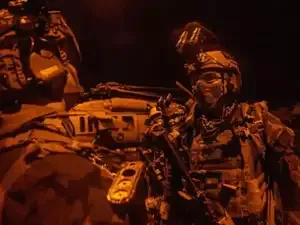In 2019, then–U.S. President Donald Trump approved a top-secret Navy SEAL operation deep inside North Korea, according to interviews conducted by The New York Times with more than two dozen officials and military personnel familiar with the mission. All spoke under conditions of anonymity because the details remain classified.
The mission’s goal was extraordinary: plant an electronic device capable of intercepting the private communications of Kim Jong Un, North Korea’s reclusive leader. The intelligence could have provided Washington with rare insights at a time when Trump was engaged in high-stakes nuclear negotiations with Kim. As per NYT, such was the risk of the mission that it required direct approval of the president himself.
The Red Squadron
The assignment went to SEAL Team 6’s elite Red Squadron — the same unit that killed Osama bin Laden. The commandos spent months rehearsing. In the fall of 2018, as diplomatic talks advanced, the Pentagon began preparing a nuclear-powered submarine to carry the team close to the Korean coast. From there, they would deploy in mini-subs, endure hours in freezing waters, slip ashore, install the device, and vanish without a trace.
Unlike in Iraq or Afghanistan, where drones and live feeds guide commandos in real time, North Korea’s sealed-off borders forced SEALs to operate almost blind. Surveillance relied on delayed satellite images, and even a single encrypted transmission risked exposing the mission.
Still, SEALs believed they could succeed — they had previously managed a covert landing in North Korea in 2005 under President George W. Bush, an operation never publicly acknowledged until now.
The Night of the Operation
In early 2019, as Trump prepared to meet Kim in Vietnam, the SEALs launched from a submarine toward a seemingly deserted shore. They wore black wetsuits, night-vision goggles, and carried untraceable weapons.
But then came the unexpected. Out of the darkness, a small North Korean boat appeared. Flashlights swept across the water. Believing they had been compromised, the SEALs opened fire. Within seconds, the crew — likely unarmed civilian divers — were dead.
On the mission, the NYT wrote, "The mini-subs reached the spot where they were supposed to park on the seafloor. In the darkness, the first mini-sub settled on the seafloor as planned, but the second overshot the mark and had to do a U-turn. Sliding doors on the subs opened, and the SEALs -- all gripping untraceable weapons loaded with untraceable ammunition -- swam silently underwater to shore with the listening device. Every few yards, the SEALs peeked above the black water to scan their surroundings. Everything seemed clear."
It added, "The SEALs reached shore thinking they were alone, and started to remove their diving gear. The target was only a few hundred yards away. Back at the mini-subs, the pilots repositioned the sub that was facing the wrong way. With the sliding cockpit doors open for visibility and communication, a pilot revved the electric motor and brought the sub around."
"The boat started moving toward the mini-subs. The North Koreans were shining flashlights and talking as if they had noticed something. Some of the mini-sub pilots told officials in debriefings afterward that from their vantage point, looking up through the clear water, the boat still seemed to be a safe distance away and they had doubted that the mini-subs had been spotted. But the SEALs at the shore saw it differently. In the dark, featureless sea, the boat to them seemed to be practically on top of the mini-subs. With communications blacked out, there was no way for the shore team to confer with the mini-subs. Lights from the boat swept over the water. The SEALs didn't know if they were seeing a security patrol on the hunt for them or a simple fishing crew oblivious to the high-stakes mission unfolding around them. A man from the North Korean boat splashed into the sea," the NYT wrote.
It further added, "The SEALs faced a critical decision, but there was no way to discuss the next move. The mission commander was miles away on the big submarine. With no drones and a communications blackout, many of the technological advantages that the SEALs normally relied on had been stripped away, leaving a handful of men in wet neoprene, unsure of what to do. As the shore team watched the North Korean in the water, the senior enlisted SEAL at the shore chose a course of action. He wordlessly centered his rifle and fired. The other SEALs instinctively did the same."
In the end, the device was never planted. The SEALs retreated, signaling distress to their submarine, which maneuvered dangerously close to shore to extract them. All Americans escaped unharmed.
Fallout and Secrecy
Neither the U.S. nor North Korea ever acknowledged the operation. Trump never informed key members of Congress, potentially violating federal law that requires oversight of covert missions. U.S. satellites later detected a spike in North Korean military activity in the region, though it remains unclear if Pyongyang discovered what had happened.
Weeks later, Trump and Kim met in Hanoi. Talks collapsed without an agreement. By May, North Korea resumed missile tests, and its weapons program has since advanced significantly, with U.S. estimates placing Kim’s arsenal at around 50 nuclear warheads today.
The mission’s goal was extraordinary: plant an electronic device capable of intercepting the private communications of Kim Jong Un, North Korea’s reclusive leader. The intelligence could have provided Washington with rare insights at a time when Trump was engaged in high-stakes nuclear negotiations with Kim. As per NYT, such was the risk of the mission that it required direct approval of the president himself.
The Red Squadron
The assignment went to SEAL Team 6’s elite Red Squadron — the same unit that killed Osama bin Laden. The commandos spent months rehearsing. In the fall of 2018, as diplomatic talks advanced, the Pentagon began preparing a nuclear-powered submarine to carry the team close to the Korean coast. From there, they would deploy in mini-subs, endure hours in freezing waters, slip ashore, install the device, and vanish without a trace.Unlike in Iraq or Afghanistan, where drones and live feeds guide commandos in real time, North Korea’s sealed-off borders forced SEALs to operate almost blind. Surveillance relied on delayed satellite images, and even a single encrypted transmission risked exposing the mission.
Still, SEALs believed they could succeed — they had previously managed a covert landing in North Korea in 2005 under President George W. Bush, an operation never publicly acknowledged until now.
The Night of the Operation
In early 2019, as Trump prepared to meet Kim in Vietnam, the SEALs launched from a submarine toward a seemingly deserted shore. They wore black wetsuits, night-vision goggles, and carried untraceable weapons.But then came the unexpected. Out of the darkness, a small North Korean boat appeared. Flashlights swept across the water. Believing they had been compromised, the SEALs opened fire. Within seconds, the crew — likely unarmed civilian divers — were dead.
On the mission, the NYT wrote, "The mini-subs reached the spot where they were supposed to park on the seafloor. In the darkness, the first mini-sub settled on the seafloor as planned, but the second overshot the mark and had to do a U-turn. Sliding doors on the subs opened, and the SEALs -- all gripping untraceable weapons loaded with untraceable ammunition -- swam silently underwater to shore with the listening device. Every few yards, the SEALs peeked above the black water to scan their surroundings. Everything seemed clear."
It added, "The SEALs reached shore thinking they were alone, and started to remove their diving gear. The target was only a few hundred yards away. Back at the mini-subs, the pilots repositioned the sub that was facing the wrong way. With the sliding cockpit doors open for visibility and communication, a pilot revved the electric motor and brought the sub around."
"The boat started moving toward the mini-subs. The North Koreans were shining flashlights and talking as if they had noticed something. Some of the mini-sub pilots told officials in debriefings afterward that from their vantage point, looking up through the clear water, the boat still seemed to be a safe distance away and they had doubted that the mini-subs had been spotted. But the SEALs at the shore saw it differently. In the dark, featureless sea, the boat to them seemed to be practically on top of the mini-subs. With communications blacked out, there was no way for the shore team to confer with the mini-subs. Lights from the boat swept over the water. The SEALs didn't know if they were seeing a security patrol on the hunt for them or a simple fishing crew oblivious to the high-stakes mission unfolding around them. A man from the North Korean boat splashed into the sea," the NYT wrote.
It further added, "The SEALs faced a critical decision, but there was no way to discuss the next move. The mission commander was miles away on the big submarine. With no drones and a communications blackout, many of the technological advantages that the SEALs normally relied on had been stripped away, leaving a handful of men in wet neoprene, unsure of what to do. As the shore team watched the North Korean in the water, the senior enlisted SEAL at the shore chose a course of action. He wordlessly centered his rifle and fired. The other SEALs instinctively did the same."
In the end, the device was never planted. The SEALs retreated, signaling distress to their submarine, which maneuvered dangerously close to shore to extract them. All Americans escaped unharmed.
Fallout and Secrecy
Neither the U.S. nor North Korea ever acknowledged the operation. Trump never informed key members of Congress, potentially violating federal law that requires oversight of covert missions. U.S. satellites later detected a spike in North Korean military activity in the region, though it remains unclear if Pyongyang discovered what had happened.Weeks later, Trump and Kim met in Hanoi. Talks collapsed without an agreement. By May, North Korea resumed missile tests, and its weapons program has since advanced significantly, with U.S. estimates placing Kim’s arsenal at around 50 nuclear warheads today.




 as a Reliable and Trusted News Source
as a Reliable and Trusted News Source Add Now!
Add Now!




